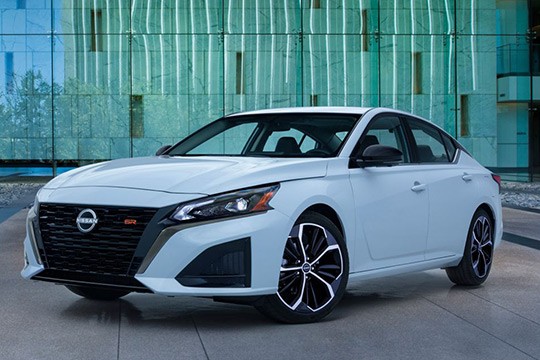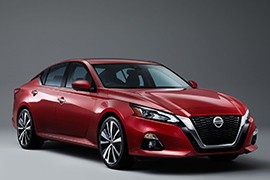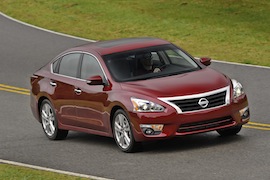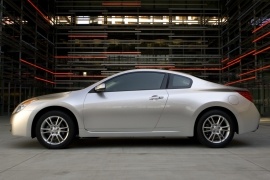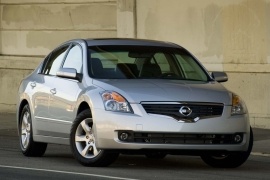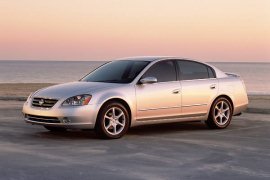NISSAN Altima Models/Series Timeline, Specifications & Photos
First production year: 2002
Engines: Gasoline, Hybrid
Nissan introduced the sixth generation of the Altima in 2019, and four years later, it introduced a well-deserved facelift for it.
The 2023 Altima was vastly improved not only on the outside but also on the trim level specifications and safety features. Thus, customers could choose from up to eight versions of the midsize sedan. Previously, the Altima was available in five trim levels. Still, the carmaker reduced that number to four and re-arranged the standard amenities.
Obviously, the most noticeable change on the Altima was the front fascia. Nissan dropped the chromed V-shaped trim from the front and left only a "black chrome" grille to support the round, chromed badge. Moreover, the side clusters were larger, offering a more aggressive stance for the vehicle. On the other hand, the headlights were LEDs as standard, which made the foglights obsolete and deleted them.
Inside, the cabin featured new amenities, such as the optional 12.3" touch-screen that resembled the one installed on the Altima's bigger sibling, the Armada. At the bottom of the center stack, Nissan offered a wireless charger, USB-C, USB, and charger ports. On the safety segment, the carmaker included the ProPilot Assist for the 2.5 SL and the 2.0 SR VC Turbo trim levels.
Under the hood, the carmaker kept the same powerplants mated to the sluggish Nissan Xtronic (CVT) gearbox that sent the power to the front or all corners of the car.
Nissan unveiled the sixth generation of the Altima at the 2018 New York International Auto Show, and it came with significant improvements over its predecessor.
Since the first generation appeared in 1993, the Altima was a formidable contender in the mid-size segment, especially since the carmaker made it technologically advanced. For instance, the first Altima featured a head-up display, which was unheard of for most cars. The second generation, launched in 1998, featured a keyless entry system. The innovations continued on the following generations, and Nissan sold 5.6 million Altimas in 25 years.
For the 2018 model, the carmaker introduced the new design language from the Vmotion 2.0 Concept car. Its chromed, broad, chromed V-shaped trim on the grille and the swept-back angular headlights were more on the sporty side of the segment than on the same page with its main competitors, Honda Accord and Toyota Camry. Its muscular profile with a raised beltline in front of the sloped C-pillar, and black trim, induced the idea of a floating roof, while the short decklid that sported a lip spoiler confirmed the sporty car's character.
Inside, the Altima featured a broad dashboard with a silver, V-shaped trim that ran across the front side of the panel. The carmaker installed a touch-screen display for the infotainment unit placed above the center stack. It supported the Android Auto and Apple CarPlay connectivity, while the center console with a minimalist design. A piano-black trim adorned it.
Another significant change was under the skin, where Nissan introduced an all-wheel-drive version for the first time on an Altima. The carmaker offered the mid-size sedan with a choice of two engines: a 2.5-liter naturally aspirated and 2.0-liter turbocharged unit.
The fifth generation of the Nissan Altima was unveiled at the 2012 New York International Auto Show as the 2013 model. It entered the competition on the mid-size sedans.
The competitive mid-size sedan segment made the Japanese car-manufacturer Nissan bring more Infiniti style into the mass-market vehicles. The 2013 Altima was based on the same platform with the Maxima and the Murano. Moreover, it had an Infiniti M30 look.
New styling, with the Z-shape inspiration from the Nissan Z sports model, was applied. New front bumpers, with bolder styling, were applied and a nice, chromed line, surrounded the side glass area of the greenhouse. A big improvement was made to the weight of the car, due to the aluminum hood, roof, and trunk lid.
For the inside, the car featured the Nissan Connect infotainment system on the central part of the dashboard, with navigation, rear-view camera, XM satellite radio, and, of course, Bluetooth connectivity. The instrument cluster featured two, big, analog dials for the speedometer and tachometer and a TFT display in between them for the driver information center. For the rear passengers, a nearly flat floor helped for three seating positions. Two air-vents were provided to add climate comfort.
Under the hood, there were two engine choices: a four-pot 2.5-liter and a 3.5-liter V6 unit. The standard transmission for both was a CVT unit that helped increase the fuel-efficiency.
While the fifth generation of the Altima sedan was introduced at the 2012 New York Auto Show, the coupe version received a mild facelift where it gained some, and it lost some.
The design team took its inspiration from the acclaimed GTR when it drew the lines of the Altima Coupe, but it had to keep the front-wheel-drive platform from the regular Altima. It was the last year when this body shape was offered. Starting with the fifth generation, the carmaker dropped the two-door version.
At the front, the designers took the shape of the headlights from the GTR, with a swept-back look on top of the fenders. The wide grille between them featured a chromed surrounding. Unlike the rest of the Altima range, the coupe version featured a bulge on the hood, evoking a sportier character. Its raked windshield, short roof, and long, sloped rear end resembled the 370Z shape.
Inside, it was a 2+2 configuration, but due to the low interior height, it might be considered only as a two-seat option. In the back, only a couple of toddlers might be seated. Nissan offered the Altima Coupe with only one trim level. It featured a six-speaker sound system and a 4" monitor. At least, the infotainment unit featured Bluetooth connectivity.
Under the hood, Nissan dropped the 3.5-liter V6 engine and left only the 2.5-liter four-mill under the hood. The standard transmission was Nissan's CVT gearbox with paddle-shifters behind the steering wheel.
Most people associate sportiness with a 2-door body style, and while the Nissan Altima was one of the sports midsize sedans on the market, Nissan decided to complete the range with a coupe.
Sharing only the hood with the 4-door Altima, the sporty coupe featured a unique body work with swept back headlights, a sleek roofline, flowing body lines, dual exhaust outlets and pronounced fenders. The roof pillar gracefully merged with the rear deck lid, the Altima coupe looking like a more expensive vehicle.
Inside, the cabin was fitted with high quality materials and sport front seats with good bolstering. The cabin was roomy for the front passengers, however, the limited space available in the back and the uneasy access to the rear seats made the coupe a less good option for those travelling with more passengers.
The trunk could accommodate a decent amount of cargo and the split folding rear seats could expand the usefulness of the trunk.
The Altima coupe was fun to drive with a lively handling and a good steering feedback, however, the ride was a bit firm.
Equipped with top-notch technology, the Altima could be equipped a touchscreen navigation system with a rearview camera that offered lots of useful information, air-conditioning, a 6 speaker audio system as standard or a premium 6-speaker Bose sound system, power windows, door lock and mirrors, as well as keyless go.
A choice of two engines was available, a 2.5-liter with 170 hp and a 3.5-liter V6 unit developing 270 hp. The 4-cylinder powerplant offered power and refinement, whereas the V6 unit perfectly matched the sporty demeanour of the affordable coupe.
The engine could be both mated with a 6-speed manual transmission or a CVT gearbox.
Safety wise, the coupe offered a tyre pressure monitor, 6 airbags, ABS and active head restraints.
The 2007 Nissan Altima was unveiled at the 2006 New York Auto Show in April as a 2007 model. It was based on a new D-Platform, tailored and shortened for the fourth generation of the Altima.
The Nissan Altima was revived in 2002 and it was a popular choice for customers interested in a sport-oriented sedan. Its predecessor was known for good road-handling. The 2008 model was improved in the areas where it was criticized.
The car featured a raked front fascia and a sleek roofline. Its curvy lines and bold stance were part of the sporty sedan. In 2009, the Nissan Altima went through a mild facelift that changed the grille and the headlights, making it more appealing to the customers.
On the inside, the Altima was well equipped even in the base trim level. It featured Bluetooth connectivity fitted as standard on all models, Velour cloth seat trim, keyless entry, and push-button start. For the occupant's comfort, the car-maker installed 8 cup-holders for the passengers.
The Altima was offered with a 2.5-liter engine mated to a 6-speed manual as standard. A 3.5-liter V6 and a CVT gearbox were offered as options, on higher trim levels. For the safety systems, the 2008 Altima featured ABS along with electronic brake-force distribution. After the facelift, in 2009, all range was equipped with ESP. Before 2009 it was available only for the V6 model.
Reaching its 3rd generation in 2002, the Nissan’s midsize sedan suffered a complete makeover, managing to achieve an unseen performance in the class.
The exterior design became more aggressive compared to the previous versions and all of its dimensions were increased to offer even more comfort.
The Altima was offered in 4 trim levels, each of their nomenclatures referring to the engine’s size: base 2.5, 2.5 S, 2.5 SL and 3.5 SE. The engines were powerful, with the most agile developing around 200 hp.
The interior was customisable, borrowing different “Atmosphere” interior schemes from Audi, customers having to choose between Charcoal, Blond or Frost cabin colors. The interior was also accessorised with fake wood and titanium trims on the dashboard and door panels.
Easy to find the suitable driving position, the Altima was equipped with a tilt and telescopic steering wheel. For enhanced comfort, the upper trims featured steering wheel-mounted controls. Leather seating was also available, as well as an auto-dimming rearview mirrors. An optional Cold packaged included heated seats and outside mirrors.
Safety wise, the Altima offered side-impact curtain airbags, dual-stage front airbags, traction control for the automatic V6 models, antilock brakes and child-seat anchors.
The suspension on the Altima was borrowed from the Nissan’s supercar Skyline and was very appreciated.
